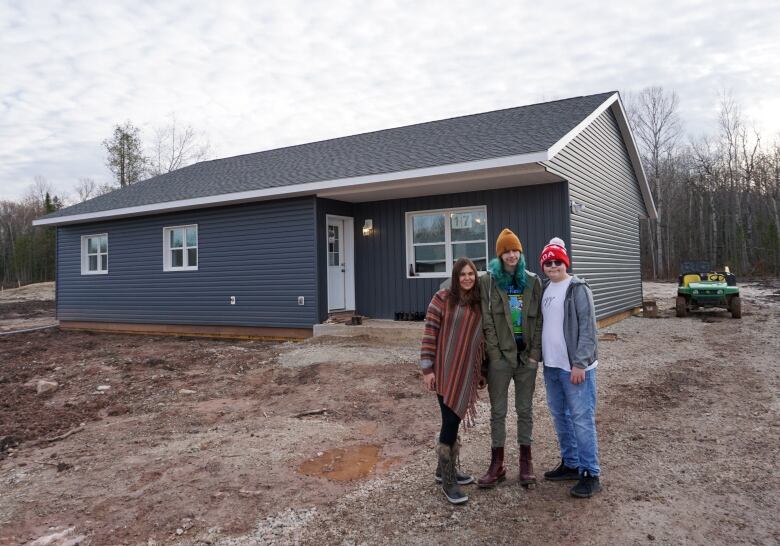Net-zero home in Indigenous community wins UW students award from U.S. Department of Energy
Members of the Warrior Home team placed second at a competition run by U.S. Department of Energy

Members of a design team at the University of Waterloo placed second at the 2020 Solar Decatholonbuild challenge, which isput on by the United States Department of Energy, for designing and building a net-zero energy home in an Indigenous community near Wiarton.
The project, which started in late 2017, was completed in collaboration with the Chippewa of Nawash UncededFirst Nation and Habitat for Humanity Grey Bruce.
The result is a four-bed, two-bath bungalow which is now home to a family of five in theNeyaashiinigmiingreserve near Wiarton, ON. The home generates all of its energy needs through 37 solar panels on its roof. It's also equipped with smart plugs and smart thermostats to monitor and minimize its energy usage, among other energy-efficient features.
Jeffrey Ren, a fourth-year planning student at the University of Waterloo and senior project manager with Warrior Home, says that though the home has many special features, the team wanted it to fit in with other housesinthe community.
"I think that's a big part of our designto show that this kind of sustainable and affordable net-zero energy design home, that is able to generate all the power that it uses, is something that you could see on any sort of street corner anywhere," he said.
WATCH| The UW team put together this video about the Warrior Home:
The total cost of the home was approximately $220,000, which is around$30,000 more than the 19 surrounding homes in the development.
"Overall, I think our project really demonstrates just how affordable and accessible a lot of the sustainable, new technologies and design methodologies are for housing," he continued.
Praise for design
The design process took between six to eight monthsand building was completed within a year and a half with the help of volunteers. When it was completed, the team gave ownership of the home to the Chippewa of Nawash, who incorporated it into their affordable rent-to-own housing program.
The resident of the home, who moved in in December of 2019,has a child who has visual impairments, so the Warrior Home team factored accessibility features into the design as well.
"We've been in contact with the homeowner and she said that she's been enjoying the house and she absolutely loves it," said Gabrielle Tuck, a design lead with the team who's also in her final year of civil engineering at the University of Waterloo.

The resident, Melissa Millette, who previously lived in Hamilton, says in a YouTube video produced by the Warrior Home team that she "felt like she won the lottery" with the home.
"I get to be closer to my parents, I get to be close to my mom, I get to be here and be a part of our community which we always wanted to," she said.
Tuck says the Chippewa of Nawashliked the design of the house so much that they've considered using it for future developments.
"So to see that those things could be carried over into numerous houses is great, because we didn't just make an impact for that one family, that one home, but potentially for far more families and for far more homes and potentially even more than just that one community," she said.
And praise didn't just come from the resident and members of the community, but also from the United States Department of Energy. Through its Solar DecatholonBuild Challenge, a student competition, it awarded the team second place,a trophy presented by U.S. Secretary of Energy Jennifer Granholm, and $20,000 USD. The team learned they had won the prize on April 18.
The team members say that prize money was donated Chippewas of Nawash and usedto cover costs associated with the net-zero energy design of the home, including costs for the solar panels and insulation.
Building solutions
Ren says the project has taught him that students can address important issues.
"I think that a lot of time for students learning about these things it can seem almost hopeless and too much of a daunting task to do anything about these huge, huge issues that we learn about," he said.
"And having Warrior Home, you really get to apply your learning and figure out a way to take what you've learned in all your classesand really find a solution in the real world and apply that."
Tuck says the team has been able to spread that hope through their work.
"We had open learning sessions, we were able to reach out to more people and show them that affordable, sustainable housing is actually something that's possible.We were able to spread awareness about the housing crisis that's occurring in many Indigenous areas of Canada," she said.
"That reach and that ability to know that we were able to impact so many lives positively is kind of what inspired me throughout the years."












_(720p).jpg)


 OFFICIAL HD MUSIC VIDEO.jpg)
.jpg)



























































































